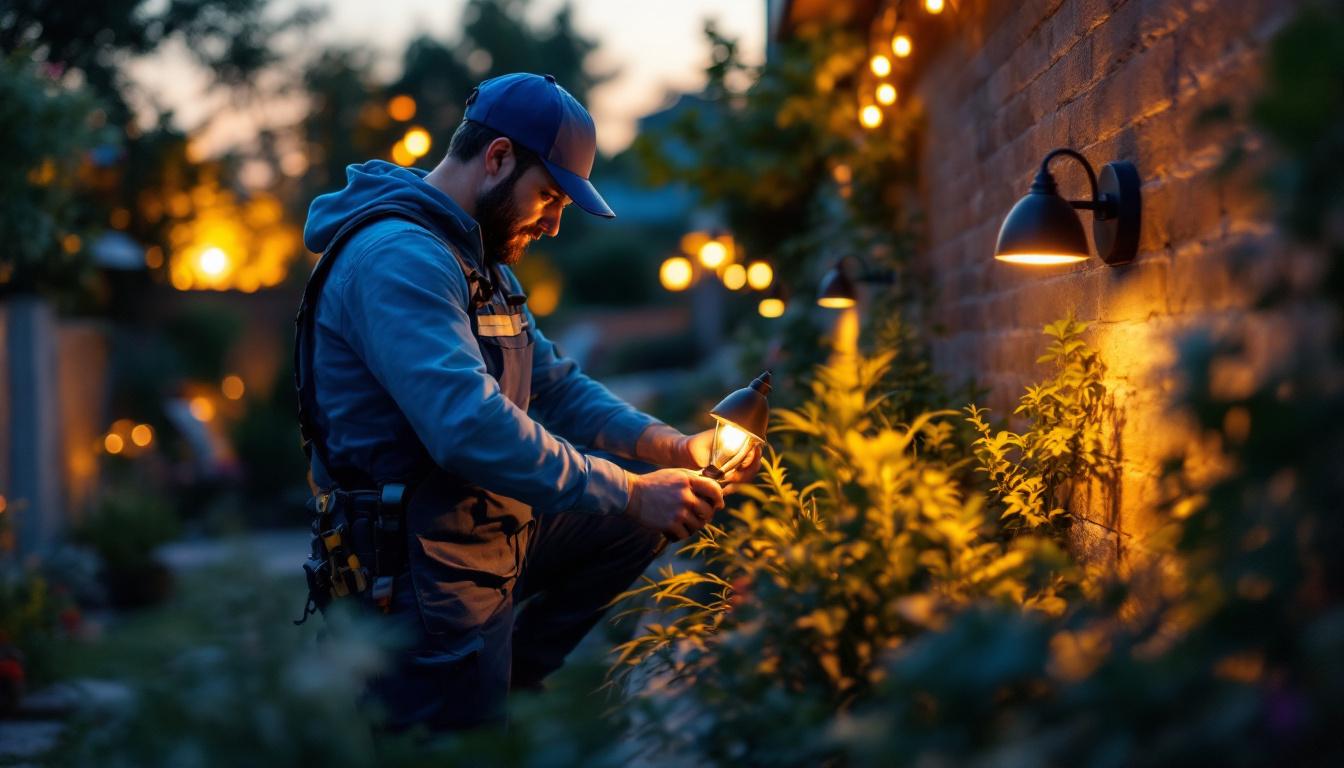
For lighting contractors, small outdoor light fixtures are more than just decorative elements—they are essential tools that enhance safety, aesthetics, and functionality in outdoor spaces. These compact fixtures play a pivotal role in illuminating pathways, accentuating architectural features, and providing security lighting without overwhelming the environment.
Outdoor lighting projects demand a balance between form and function. Small fixtures offer versatility and subtlety, allowing contractors to create layered lighting schemes that complement the landscape and architecture. Their size makes them ideal for installations where space is limited or where discreet illumination is desired.
Moreover, advancements in LED technology and durable materials have expanded the capabilities of small outdoor fixtures, making them energy-efficient, long-lasting, and adaptable to various design requirements. For contractors, understanding these fixtures’ attributes and applications is crucial to delivering high-quality, client-satisfying results.
In addition to their practical applications, small outdoor light fixtures can significantly enhance the ambiance of outdoor areas. By strategically placing these fixtures along pathways or around garden beds, contractors can create inviting spaces that encourage outdoor activities during the evening hours. The warm glow of well-placed lighting not only enhances safety but also transforms a simple backyard into a cozy retreat, perfect for gatherings or quiet evenings under the stars.
Furthermore, the aesthetic appeal of small fixtures can be tailored to match the style of the property. From sleek modern designs to rustic lanterns, there is a wide array of options available that can harmonize with the existing architecture and landscape. This customization allows homeowners to express their personal style while ensuring that the lighting serves its intended purpose. As such, lighting contractors must stay informed about the latest trends and innovations in outdoor lighting to provide their clients with the best possible solutions that marry beauty with functionality.
Path lights are among the most common small outdoor fixtures used by lighting contractors. Typically installed along walkways, driveways, and garden paths, these fixtures provide guidance and enhance safety during nighttime hours. Their low-profile design ensures they do not obstruct foot traffic or detract from the landscape.
Modern path lights often feature solar-powered or low-voltage LED options, which reduce installation complexity and energy consumption. Contractors should consider fixture height, light output, and beam angle to ensure even illumination and avoid glare. Additionally, the aesthetic design of path lights can complement various architectural styles, from contemporary to rustic, allowing homeowners to maintain a cohesive look throughout their outdoor spaces. By strategically spacing these lights, contractors can create a visually appealing pathway that not only serves a functional purpose but also enhances the overall ambiance of the garden or yard.
Step lights are essential for illuminating staircases and changes in elevation in outdoor environments. These fixtures are usually recessed into walls or steps, providing subtle, downward-directed light that improves visibility and reduces trip hazards.
Durability and weather resistance are critical factors since step lights are exposed to foot traffic and environmental elements. Lighting contractors must select fixtures with robust housings and appropriate ingress protection ratings to ensure longevity and safety. Furthermore, step lights can be integrated with smart home systems, allowing homeowners to control their lighting remotely or set timers for automatic illumination. This not only enhances convenience but also contributes to energy savings, as lights can be programmed to turn off during daylight hours. The use of dimmable options can also create a softer, more inviting atmosphere during evening gatherings.
Small accent and spot lights are used to highlight architectural details, landscaping features, or outdoor art installations. Their focused beam allows contractors to draw attention to specific areas, creating visual interest and depth in outdoor lighting designs.
These fixtures often come with adjustable heads or swivel mounts, enabling precise aiming. Selecting fixtures with appropriate color temperature and beam spread is vital to achieving the desired effect without overpowering the surroundings. In addition to their practical applications, accent and spot lights can also be used creatively to transform outdoor spaces into enchanting environments. For instance, uplighting can be employed to cast dramatic shadows on trees or walls, while downlighting can mimic natural moonlight, providing a serene and inviting atmosphere. By combining different types of lighting, contractors can craft layered lighting designs that not only enhance safety but also elevate the beauty of the outdoor landscape.
Outdoor light fixtures face constant exposure to weather conditions such as rain, wind, UV radiation, and temperature fluctuations. For lighting contractors, choosing fixtures made from durable materials is essential to ensure long-term performance and reduce maintenance needs.
Common materials include die-cast aluminum, stainless steel, and high-grade plastics. Die-cast aluminum offers excellent corrosion resistance and strength while remaining lightweight. Stainless steel fixtures provide superior durability and a sleek appearance but may come at a higher cost. High-quality plastics can be UV stabilized and impact-resistant, offering budget-friendly options for certain applications.
Finishes such as powder coating or anodizing enhance corrosion resistance and aesthetic appeal. Contractors should also verify that fixtures have appropriate IP (Ingress Protection) ratings, typically IP65 or higher, to guarantee protection against dust and water ingress.
In addition to the materials mentioned, it’s important to consider the environmental impact of the chosen fixtures. Recyclable materials not only contribute to sustainability efforts but also appeal to eco-conscious consumers. For instance, fixtures made from recycled aluminum can significantly reduce the carbon footprint associated with production. Moreover, the use of energy-efficient LED bulbs in conjunction with durable fixtures can further enhance the longevity and efficiency of outdoor lighting solutions, making them an attractive option for both residential and commercial applications.
Another critical aspect to consider is the design of the fixtures themselves. Streamlined designs that minimize crevices and joints can help reduce the accumulation of dirt and moisture, which can lead to corrosion over time. Additionally, selecting fixtures with integrated heat sinks can improve the performance and lifespan of the lighting components by dissipating heat effectively. This attention to detail not only contributes to the durability of the fixtures but also ensures that they maintain their aesthetic appeal over time, providing reliable illumination for years to come.
Energy efficiency is a critical consideration in outdoor lighting projects, both from environmental and operational cost perspectives. Small outdoor light fixtures equipped with LED technology offer significant advantages over traditional incandescent or halogen bulbs.
LEDs consume substantially less power, generate less heat, and have longer lifespans, often exceeding 50,000 hours. This reduces replacement frequency and maintenance costs, which is particularly beneficial for hard-to-access outdoor installations.
Additionally, many modern fixtures incorporate smart controls, such as motion sensors, photocells, and programmable timers. These features enable lighting contractors to design systems that optimize energy usage by activating lights only when needed, further enhancing sustainability and client satisfaction.
Proper installation is paramount to maximizing the performance and lifespan of small outdoor light fixtures. Lighting contractors should adhere to industry standards and manufacturer guidelines to ensure safe and effective setups.
Key considerations include:
By following these best practices, lighting contractors can deliver installations that are safe, reliable, and visually appealing.
The outdoor lighting industry continues to evolve, driven by technological advancements and changing client preferences. Lighting contractors should stay informed about emerging trends to offer cutting-edge solutions.
One notable trend is the integration of smart lighting systems. These allow remote control via smartphones or voice assistants, enabling users to customize lighting scenes, adjust brightness, and schedule operation times seamlessly.
Another innovation is the use of sustainable materials and eco-friendly manufacturing processes. Clients increasingly seek environmentally responsible options, prompting contractors to prioritize fixtures with recycled components and low environmental impact.
Additionally, advancements in optics and lens design have improved the quality and precision of light distribution, allowing for more creative and efficient lighting designs using small fixtures.
Small outdoor light fixtures are indispensable tools for lighting contractors aiming to deliver effective, attractive, and durable outdoor lighting solutions. Their versatility, combined with advancements in materials and technology, empowers contractors to meet diverse client needs while optimizing energy efficiency and installation ease.
By carefully selecting appropriate fixture types, materials, and technologies, and adhering to installation best practices, contractors can enhance outdoor environments in ways that promote safety, highlight beauty, and contribute to sustainability. Staying abreast of industry trends ensures that lighting professionals remain competitive and capable of providing innovative solutions in an ever-evolving market.
Ready to elevate your outdoor lighting projects with the finest small light fixtures on the market? Look no further than LumenWholesale, where we provide contractors with exceptional, spec-grade lighting products at unbeatable wholesale prices. Say goodbye to local distributor markups and hello to a vast selection of industry-standard lighting that promises reliability and high performance for every project. With the added benefits of free shipping and bulk buying convenience, LumenWholesale is your go-to source for premium lighting solutions that blend quality, affordability, and ease. Don’t miss out on the best value for your lighting needs. Visit Wholesale Lighting at the Best Value and make your next outdoor lighting project shine with LumenWholesale.

Discover the frequent pitfalls lighting contractors encounter with lamp post outdoor lighting.

Discover the essential checklist for lighting contractors transitioning from fluorescent to LED systems.

Explore the top challenges lighting contractors face with commercial lighting fixtures, from evolving technology to energy efficiency demands.

Discover how ultraviolet lamps can revolutionize cost efficiency for lighting contractors.